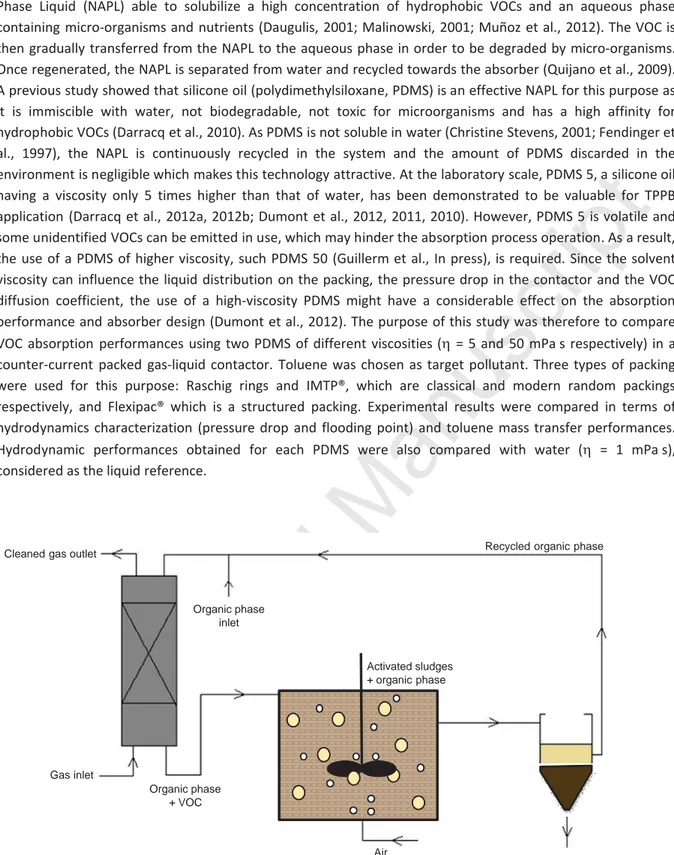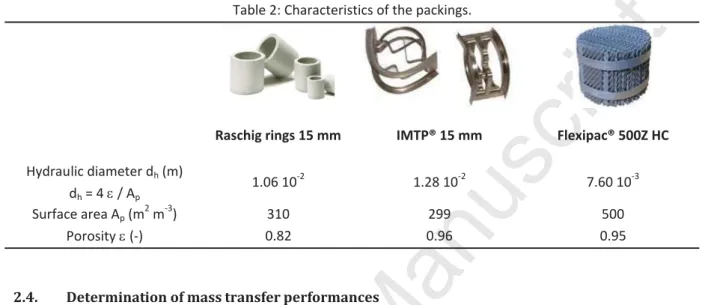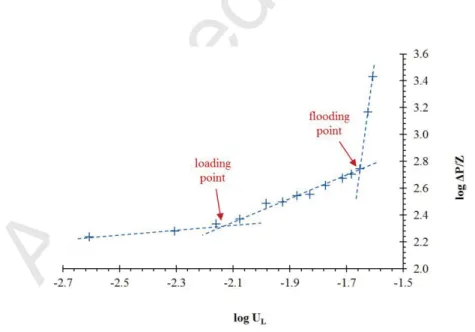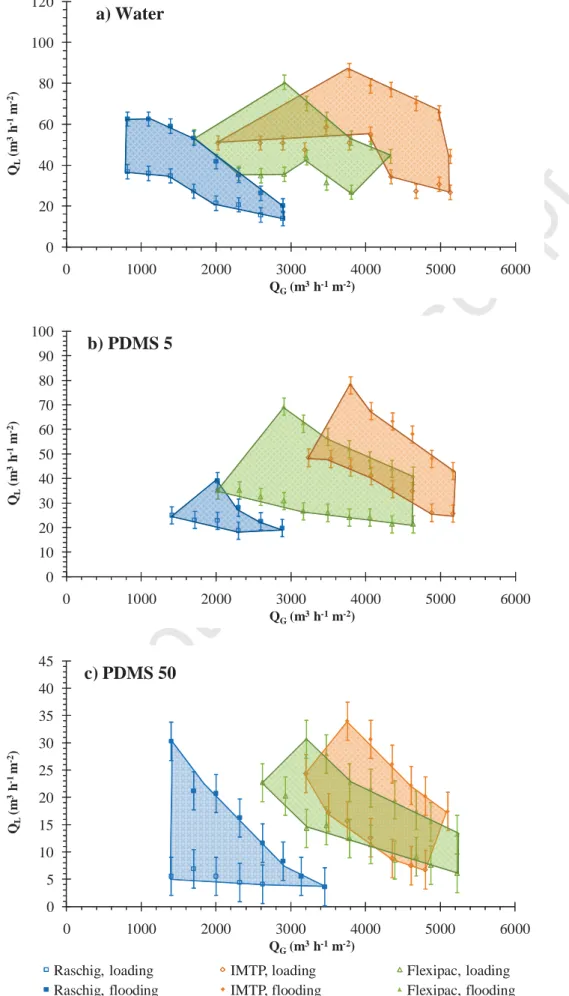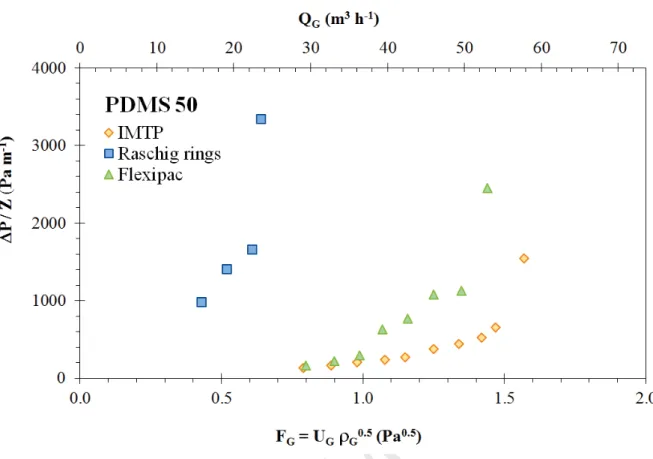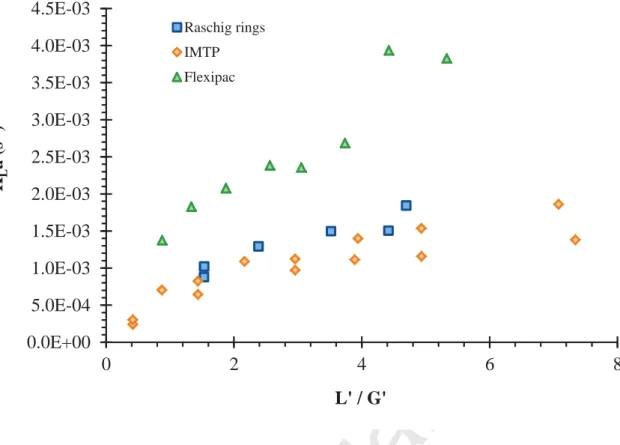HAL Id: hal-01259408
https://hal-univ-rennes1.archives-ouvertes.fr/hal-01259408
Submitted on 28 Jan 2016
HAL is a multi-disciplinary open access
archive for the deposit and dissemination of
sci-entific research documents, whether they are
pub-lished or not. The documents may come from
teaching and research institutions in France or
abroad, or from public or private research centers.
L’archive ouverte pluridisciplinaire HAL, est
destinée au dépôt et à la diffusion de documents
scientifiques de niveau recherche, publiés ou non,
émanant des établissements d’enseignement et de
recherche français ou étrangers, des laboratoires
publics ou privés.
Absorption of toluene in silicone oil: effect of the solvent
viscosity on hydrodynamics and mass transfer
Maxime Guillerm, Annabelle Couvert, Abdeltif Amrane, Edith Norrant,
Nicolas Lesage, Eric Dumont
To cite this version:
Maxime Guillerm, Annabelle Couvert, Abdeltif Amrane, Edith Norrant, Nicolas Lesage, et
al..
Absorption of toluene in silicone oil:
effect of the solvent viscosity on hydrodynamics
and mass transfer.
Chemical Engineering Research and Design, Elsevier, 2016, 109, pp.32-40.
�10.1016/j.cherd.2015.12.028�. �hal-01259408�
Accepted Manuscript
Highlights
Toluene absorption in silicone oils (PDMS 5 mPa.s and PDMS 50 mPa.s) is studied
Three packings (Raschig, IMTP and Flexipac) are tested in a counter-current contactor
100% removal efficiency can be reached for both PDMS using Flexipac
The volatility of PDMS 5 impedes its implementation in an industrial process
PDMS 50 will be a suitable absorbing liquid for the treatment of toluene
Accepted Manuscript
Absorption of toluene in silicone oil: effect of the solvent
viscosity on hydrodynamics and mass transfer
Maxime GUILLERM,1,2 Annabelle COUVERT,1,2 Abdeltif AMRANE,1,2 Edith NORRANT,3 Nicolas LESAGE,4, Éric
DUMONT,*5
1École Nationale Supérieure de Chimie de Rennes, UMR CNRS 6226, 11 allée de Beaulieu, CS 50837, 35708
Rennes Cedex 7, France
2Université Européenne de Bretagne, France 3
UCB BioPharma sprl, Avenue de l'Industrie B 1420 Braine l'Alleud, Belgium
4
Total S.A., CSTJF - Avenue Larribau, CA 374, 64018 Pau Cedex, France
5UMR CNRS 6144 GEPEA, École des Mines de Nantes, La Chantrerie, 4 rue Alfred Kastler, B.P. 20722, 44307
Nantes Cedex 3, France
*Corresponding author: email: eric.dumont@mines-nantes.fr
Abstract
The purpose of this study was to compare toluene absorption performances using two PDMS of different viscosities (K = 5 and 50 mPa s respectively) in terms of hydrodynamics and mass transfer. Three types of packing were tested in a counter-current packed gas-liquid contactor, Raschig rings, IMTP®, and Flexipac®. Hydrodynamic results showed that the viscosity of PDMS 50 is not a hurdle to be used with IMTP® or Flexipac®; the pressure drop being around 288 Pa m-1 for Flexipac® at the flooding point (FG = 0.99 Pa1/2; L’ = 4.95 kg m-2 s -1
), which corresponds to an acceptable value for an industrial application. The determination of the loading zones showed that Raschig rings were not suitable for solvents having a high viscosity, such as PDMS 50; they resulted in high pressure drops if compared to IMTP® and Flexipac®. The mass transfer study showed that 100% removal efficiency can be reached for both PDMS using Flexipac®. For IMTP®, the removal efficiency is limited to 88% in the presence of PDMS 50. As a result, PDMS 50 should be a relevant absorbing liquid for the removal of toluene in the absorption–biodegradation process, and Flexipac® packing should be preferred to IMTP®.
Keywords: Absorption; PDMS; Silicone oil; Mass transfer; Toluene, Hydrodynamics
1. Introduction
Volatile organic compounds (VOCs) are air pollutants causing health and environmental problems. VOCs at low concentration in waste gas can be removed in bioreactors, but this technique has a poor efficiency when treating hydrophobic pollutants. One possible way to remove such pollutants is to use an absorption– biodegradation process (Figure 1) combining an absorption step in a gas-liquid contactor and a biodegradation step in a Two-Phase Partitioning Bioreactor (TPPB). A TPPB uses two immiscible liquid phases, the Non Aqueous
Accepted Manuscript
Phase Liquid (NAPL) able to solubilize a high concentration of hydrophobic VOCs and an aqueous phase containing micro-organisms and nutrients (Daugulis, 2001; Malinowski, 2001; Muñoz et al., 2012). The VOC is then gradually transferred from the NAPL to the aqueous phase in order to be degraded by micro-organisms. Once regenerated, the NAPL is separated from water and recycled towards the absorber (Quijano et al., 2009). A previous study showed that silicone oil (polydimethylsiloxane, PDMS) is an effective NAPL for this purpose as it is immiscible with water, not biodegradable, not toxic for microorganisms and has a high affinity for hydrophobic VOCs (Darracq et al., 2010). As PDMS is not soluble in water (Christine Stevens, 2001; Fendinger et al., 1997), the NAPL is continuously recycled in the system and the amount of PDMS discarded in the environment is negligible which makes this technology attractive. At the laboratory scale, PDMS 5, a silicone oil having a viscosity only 5 times higher than that of water, has been demonstrated to be valuable for TPPB application (Darracq et al., 2012a, 2012b; Dumont et al., 2012, 2011, 2010). However, PDMS 5 is volatile and some unidentified VOCs can be emitted in use, which may hinder the absorption process operation. As a result, the use of a PDMS of higher viscosity, such PDMS 50 (Guillerm et al., In press), is required. Since the solvent viscosity can influence the liquid distribution on the packing, the pressure drop in the contactor and the VOC diffusion coefficient, the use of a high-viscosity PDMS might have a considerable effect on the absorption performance and absorber design (Dumont et al., 2012). The purpose of this study was therefore to compare VOC absorption performances using two PDMS of different viscosities (K = 5 and 50 mPa s respectively) in a counter-current packed gas-liquid contactor. Toluene was chosen as target pollutant. Three types of packing were used for this purpose: Raschig rings and IMTP®, which are classical and modern random packings respectively, and Flexipac® which is a structured packing. Experimental results were compared in terms of hydrodynamics characterization (pressure drop and flooding point) and toluene mass transfer performances. Hydrodynamic performances obtained for each PDMS were also compared with water (K = 1 mPa s), considered as the liquid reference.Separation
Cleaned gas outlet
Gas inlet
Organic phase + VOC
Organic phase inlet
Recycled organic phase
Air
Activated sludges + organic phase
Absorption
Biodegradation
Figure 1: Absorption–biodegradation process with organic phase regeneration for hydrophobic VOCs treatment.
Accepted Manuscript
2. Material and methods 2.1. Chemical products
The two PDMS studied were referred as PDMS 5 and PDMS 50 in relation with their dynamic viscosity given by the manufacturers. PDMS 5 and PDMS 50 were respectively Rhodorsil 47V5 and Rhodorsil 47V50, provided by Bluestar Silicones Company. PDMS properties given by the manufacturers are presented in Table 1. PDMS are linear chains of various lengths comprising alternating silicon and oxygen atoms (the Si-O-Si siloxane bond; Figure 2). The average molecular weight increases with the number of siloxane bonds.
Toluene (C7H8; CAS number: 108-88-3; purity ш 99.5%; molecular weight: 92.14 g mol-1; Sigma Aldrich) was
selected as target VOC because this compound widely used in various industries is highly hydrophobic. The partition coefficient of toluene between PDMS and air was measured through a static headspace method described in Darracq et al. (2010). For the two PDMS studied, the partition coefficient values measured at 25 °C are reported in Table 1. It can be considered that the partition coefficient does not vary with the PDMS viscosity. In other words, the affinity between toluene and PDMS is similar whatever the chain length, i.e. whatever the viscosity (Guillerm et al., in press). These partition coefficient values are significantly lower than that of toluene between water and air. Values reported in the literature range from 562 to 779 Pa m3 mol-1, whereas handbooks of physicochemical properties give an average value of 680 Pa m3 mol-1 (Mackay et al., 2010). As a result, values of the partition coefficient ratio (H’water/H’PDMS) are from 235 to 250 indicating that the
choice of these two PDMS for toluene absorption is fully justified.
Table 1: Properties of the selected PDMS at 25°C.
Manufacturer data PDMS 5 PDMS 50
Molecular mass (g mol-1) 900 - 1100 7000 - 8000
Viscosity (mPa s) 5 50
Density (kg m-3) 910 959
Superficial tension [mN/m] 19.7 20.7
Experimental measurements
Toluene partition coefficient H’ (Pa m3mol-1) 2.7 ± 0.2 2.9 ± 0.3
Figure 2: General formula of PDMS.
2.2. Experimental set-up
Figure 3 shows the experimental set-up used for toluene absorption. The inner diameter of the packed gas-liquid contactor is D = 0.12 m, and the total height of the packed bed is Z = 1 m (packing volume V = 11.3 L). The packing was held in place top and bottom by grids. The column was topped with a bespoke droplet collector
Accepted Manuscript
made in the laboratory. The polluted air was generated by injecting liquid toluene in an air stream by means of a syringe dispenser. The polluted air was then introduced into the bottom of the column and the liquid was flowed counter-currently. The air flow was regulated by means of a membrane valve placed after the fan and measured by a rotameter (GF Type SK 20 CH-8201 Schaffhausen Switzerland). The column was fed with PDMS by means of a centrifugal pump (Iwaki MD100, Iwaki America Inc.). The liquid flow rates was regulated by means of a valve and measured by a rotameter (GF type SK 11 CH-8201 Schaffhausen Switzerland). For each liquid flow rate, the gas flow was increased incrementally up to the flooding point, and pressure drops ('P) were measured using vertical U-shaped tube filled with water. All experiments were carried out in a specific room regulated in temperature. The temperature of the liquid phase was ranged from 294 to 298 K, and the gas temperature was kept constant at 298 K controlled by means of thermal exchanger. Taking into account all experiments, the difference between the temperatures of the gas and liquid phases was always lower than 3 K.Figure 3: Experimental set-up for toluene absorption.
2.3. Packings
It is well known that the selection of the packing is the key issue in the packed column design. An effective contact between gas and liquid phases without excessive pressure drop is required (Sinnott, 2005). In a counter-current absorption column, three hydrodynamic regimes can be observed: (1) below the loading point, there is no noticeable interaction between gas and liquid, and pressure drop is roughly proportional to the square of the gas velocity; (2) the loading zone, where the increase in pressure drop is due to the rapid accumulation of liquid in the packing-void volume (the pressure drop is then proportional to a gas-flow-rate power higher than 2); (3) the flooding zone, where the change in pressure drop is quite great with only a slight change in gas flow rate. As flooding represents the maximum capacity condition for a packed column, its determination is needed for new designs. A large number of studies have proposed relationships to model hydrodynamics in packed columns (Mackowiak, 2010; Piché et al., 2001). However, models usually referred to systems whose liquid viscosity is close to that of water, which is not the case of PDMS 50.
The three packings selected for this study were ceramic Raschig rings, IMTP® and Flexipac®. Raschig rings and IMTP® are classical and modern random packings, whereas Flexipac® is a structured packing. Raschig rings are pieces of tubes, whose length is approximately equal to the diameter, used in large numbers of chemical
Accepted Manuscript
engineering processes. IMTP® (INTALOX® Metal Tower Packing provided by Koch Glitsch France SA) is random packing designed especially for use in distillation operations. This packing is also largely used in absorption towers where low pressure drop is crucial. Flexipac®, provided by Koch Glitsch France SA, is a structured packing made out of corrugated sheets arranged in a crisscrossing relationship to create flow channels for the gas phase. Such configuration offers low pressure drops. The characteristics of the three packings are given in Table 2. For Raschig rings and IMTP®, the ratio column diameter / packing diameter is equal to 8 which is sufficient to avoid wall effects. The porosity of IMTP® and Flexipac® is high (0.94 and 0.95 respectively) indicating that these packings are suitable for large gas flow rates.Table 2: Characteristics of the packings.
Raschig rings 15 mm IMTP® 15 mm Flexipac® 500Z HC
Hydraulic diameter dh (m)
dh = 4 H / Ap
1.06 10-2 1.28 10-2 7.60 10-3
Surface area Ap (m2 m-3) 310 299 500
Porosity H (-) 0.82 0.96 0.95
2.4. Determination of mass transfer performances
The absorption performances were determined in terms of toluene elimination efficiency:
(1)
Incoming (CGin) and outgoing (CGout) toluene concentrations (in g m-3) were analyzed by a Flame-Ionization
Detector FID (JUM 109 L THC Analyzer).
The overall mass transfer coefficients KLa and KGa (in s-1) were determined from the following equations
(Heymes et al., 2006)):
(2)
(3)
Where H is the toluene equilibrium constant (dimensionless form of the partition coefficient) between air and the liquid considered:
(4) The alternative dimensional form of partition coefficients used in this study (H’ in Pa m3mol-1) is given by Eq. 5:
Accepted Manuscript
(5)3. Results and discussion 3.1. Hydrodynamics
The dry pressure drop measurements were carried out for the three packings (not shown). As expected, log ('P/Z) vs log (UG) were characterized by straight lines accurately modeled using Ergun equation and Takahashi
and Miyahara relationships. In dry conditions, pressure drops due to Raschig rings are significantly higher than those determined for IMTP® and Flexipac®. Such results are explained by the high porosity of IMTP® and Flexipac® which cause a better distribution of gas flow across the packed bed.
The wet pressure drop measurements were carried out for each couple “packing / liquid”. The determination of the loading zone is obtained from the analysis of the pressure drop curves log ('P/Z) = f(log (UL)) giving both
the loading point and the flooding point (Figure 4). Loading zones for each packing are given in Figure 5. Whatever the solvent used (water, PMDS 5 and PDMS 50), it can be observed that IMTP® packing is applicable at higher gas flow-rates. Raschig rings are limited to lower gas flow-rates whereas Flexipac® can be used at intermediate gas flow-rates for water and for PDMS 5, i.e. for solvents having a low viscosity. Nonetheless, for PDMS 50, Flexipac® is also efficient at higher gas flow-rates and presents similar loading zone than that of IMTP®. Considering the influence of solvent viscosity according to the packing used, Figure 6 demonstrates that loading zones are close for water and PDMS 5, in relation with their similar viscosity. However, hydrodynamic performances are significantly lower for PDMS 50 in relation with the high viscosity of this solvent; viscous liquids flow less easily in the packed column. This result is observed whatever the packing used. Nonetheless, it has to be pointed out that experimental pressure drop values measured for PDMS 50 are acceptable values for an industrial application using IMTP® or Flexipac® (Figure 7). Based on such hydrodynamic considerations, it appears that IMTP® could be a satisfactory packing for TPPB applications.
Figure 4: Loading and flooding point determination. Example of hydrodynamic zones for air/water contact using Flexipac® packing (QG = 32.9 m3 h-1; UG = 0.81 m s-1; QL from 0.1 to 1.01 m3 h-1; UL from 2 10-3 to 25 10-3 m s-1).
Accepted Manuscript
0 20 40 60 80 100 120 0 1000 2000 3000 4000 5000 6000 QL (m 3h -1 m -2) QG(m3h-1m-2)a) Water
0 10 20 30 40 50 60 70 80 90 100 0 1000 2000 3000 4000 5000 6000 QL (m 3h -1 m -2) QG(m3h-1m-2)b) PDMS 5
0 5 10 15 20 25 30 35 40 45 0 1000 2000 3000 4000 5000 6000 QL (m 3h -1 m -2) QG(m3h-1m-2)Raschig, loading IMTP, loading Flexipac, loading
Raschig, flooding IMTP, flooding Flexipac, flooding
c) PDMS 50
Accepted Manuscript
0 10 20 30 40 50 60 70 80 0 1000 2000 3000 4000 5000 6000 QL (m 3h -1 m -2) QG(m3h-1m-2)a) Raschig rings
0 20 40 60 80 100 120 0 1000 2000 3000 4000 5000 6000 QL (m 3h -1 m -2) QG(m3h-1m-2)b) IMTP
0 10 20 30 40 50 60 70 80 90 100 0 1000 2000 3000 4000 5000 6000 QL (m 3h -1 m -2) QG(m3h-1m-2)Water, loading PDMS 5, loading PDMS 50, loading
Water, flooding PDMS 5, flooding PDMS 50, flooding
c) Flexipac
Accepted Manuscript
Figure 7: Pressure drops versus gas flow rate and gas capacity factor for PDMS 50 according to the packing used (L’ =4.95 kg m-2 s-1).
3.2. Toluene mass transfer
Figure 8 shows the toluene mass transfer between air and PDMS 50 for the three packings. It can be observed that the range of flow rates investigated allows to reach 100% removal efficiency for Flexipac® and up to 96% for Raschig rings. However, removal efficiency is limited to 88% for IMTP®. Two main reasons can explain the difference observed between Flexipac® and IMTP® packings: the column hydrodynamics and the packing properties. According to the hydrodynamic study for the considered gas flow rate (40 m3 h-1, i.e. 3540 m3 h-1 m
-2
), the L’/G’ values (liquid mass flow rate-to-gas mass flow rate ratio) at the loading point are 3.0 and 3.5 for Flexipac® and IMTP® respectively, whereas at the flooding point they are equal to 5.6 and higher than 7.0 respectively (Figure 5c). As a result, the same efficient hydrodynamic behavior for the column filled with Flexipac® and for the column filled with and IMTP® can be assumed. The difference between Flexipac® and IMTP® is more probably due to the geometry of these packings. According to the data given by the manufacturers (Table 2), Flexipac® and IMTP® present surface areas significantly different (66% higher for Flexipac® relatively to IMTP®) whereas both packing have an equivalent high porosity. The importance of surface area and porosity on mass transfer has been extensively reported in the literature, especially for systems whose liquid viscosity is close to that of water. However, for systems implementing large viscosity liquids, the literature is few documented and mass transfer correlations determined for low viscosities are inaccurate (Heymes et al., 2006). Nonetheless, for a viscous fluid like PDMS 50, the influence of the packing surface area can be evidenced by KLa determination (Figure 9). The experimental conditions used for KLa and
KGa calculations according to Eqs. (2-3) for each packing are summarized in Table 3. According to Figure 9, KLa
values are ranged from 3 10-4 to 4 10-3 s-1 (KGa values calculated using Eq. (3) are from 0.3 to 4.5 s-1 for the same
operating conditions). Such results, which are low in comparison with literature data and models (up to 10-1 s
-1
Accepted Manuscript
viscous absorbent (viscosity 12.5 mPa.s at 293 K). These authors determined KLa values from 2.5 10-4 to 2.4 10-3s-1. Figure 9 highlights the significant difference between IMTP® and Flexipac® mass transfer performances. Indeed, KLa values are around twice higher for Flexipac® than for IMTP®, which can obviously be related to the
surface area of the packing (the same trend is observed for KGa change vs L’/G’ ratio; not shown). Moreover,
this observation is reinforced by the results obtained for Raschig rings. As shown in Figure 9, KLa values
determined for Raschig rings are in the same order of magnitude of KLa values obtained for IMTP®, both
packing having very similar surface areas (Table 2). Nonetheless, it has to be noted that toluene removal efficiencies recorded for Raschig rings were close to the results obtained for Flexipac® (Figure 8) whereas the surface area of Raschig rings is largely lower than that of Flexipac®. Such result can be explained because different gas flow rates were used for the mass transfer study according to the packing tested (26 m3 h-1 for Raschig rings vs 40 m3 h-1 for Flexipac®; Table 3). Indeed, according to the hydrodynamic study (Figure 5c), the flooding point is too low for the couple “Raschig rings / PDMS 50” to apply the gas flow rate used for IMTP® and Flexipac® packings. As a result, for the same toluene inlet concentration, the loading rate treated by IMTP® and Flexipac® was higher than that treated by Raschig rings, which explained the good removal efficiency of Raschig rings relatively to IMTP®. To summarize, it can be concluded that, in the case of a viscous fluid such as PDMS 50, Flexipac® presents the best mass transfer performances in relation with its high surface area. Although IMTP® is the best packing based on hydrodynamic considerations, its mass transfer performances are less good than those of Flexipac®, and similar to those of Raschig rings.
Figure 8: Mass transfer performances for PDMS 50 according to the packing used (gas flow rate: 40 m3 h-1 for IMTP® and Flexipac®, 26 m3 h-1 for Raschig rings; inlet toluene concentration: 114 mg m-3).
Accepted Manuscript
0.0E+00
5.0E-04
1.0E-03
1.5E-03
2.0E-03
2.5E-03
3.0E-03
3.5E-03
4.0E-03
4.5E-03
0
2
4
6
8
K
La(
s
-1)
L' / G'
Raschig rings IMTP FlexipacFigure 9: Overall mass transfer coefficient KLa for PDMS 50 according to the packing used.
Accepted Manuscript
The efficiency of Flexipac® packing was tested for the three solvents (Figure 10). It can be observed that the removal efficiency is less than 10% for the air/water couple and close to 100% for the air/PDMS couples. Such results confirm the choice of PDMS as an efficient absorbent for removing toluene. The difference between water and PDMS is due to the large absorption capacity of PDMS characterized by a low value of the partition coefficient (Table 1). Nonetheless, the influence of PDMS viscosity can be observed in Figure 10. For PDMS 5, 100% efficiency is reached for L’/G’ value around 3, whereas L’/G’ value around 5 is needed for PDMS 50. Such result, which highlights the negative effect of viscosity on absorption performance, clearly appears in Figure 11 giving KLa behavior according to the fluid phase. Toluene diffusion coefficient and liquid boundary layerthickness should be taken into account to explain the difference between both PDMS. However, values of toluene diffusion coefficient in PDMS are not available in the literature and the accurate experimental determination of such a physical property in viscous fluid remains always a challenge. The simultaneous influence of viscosity and solubility parameters is also clearly evidenced in Figure 12 showing KGa behavior
according to the fluid phase. According to this figure, KGa values, low for water, are significantly higher for both
PDMS in relation with the large absorption capacity of these solvents. Nonetheless, KGa values are lower for
PDMS 50 than for PDMS 5 in relation with their respective viscosity. Such result will deserve to be validated using empirical correlations. However, no correlation is currently available to accurately predict mass transfer coefficient in the case of a viscous absorbent (Heymes et al., 2006). The present results could be used to establish robust correlations in future works.
Accepted Manuscript
Figure 10: Absorption efficiency of toluene in water, PDMS 5 and PDMS 50 using Flexipac® packing (gas flowrate: 40 m3 h-1, inlet toluene concentration: 114 mg m-3).
Accepted Manuscript
0.0
1.0
2.0
3.0
4.0
5.0
6.0
0
2
4
6
8
10
12
K
Ga(
s
-1)
L' / G'
water PDMS 5 PDMS 50Figure 12: Overall mass transfer coefficient KGa for Flexipac® according to the liquid phase.
4. Conclusion
The hydrodynamics and mass transfer performance of three packings to remove toluene was investigated using water, PDMS 5 and PDMS 50 as absorbing liquids. Among the tested packings, Raschig rings appeared not relevant owing to the high pressure drops they induce in the presence of a solvent of high viscosity such as PDMS 50. Although the hydrodynamic study showed that the viscosity of PDMS 50 does not impede its use with IMTP® or Flexipac®, it appeared that performances are slightly lower than for PDMS 5 in relation with its high viscosity. Nonetheless, the pressure drops measured for PDMS 50 corresponds to an acceptable value for an industrial application. The mass transfer study showed that 100% removal efficiency can be reached for both PDMS using Flexipac®. However, the volatility of PDMS 5 impedes its implementation in the proposed process. As a result, PDMS 50 will be a relevant absorbing liquid for the treatment of toluene in the absorption–biodegradation process. For IMTP®, the removal efficiency is limited to 88% for PDMS 50, and consequently, the Flexipac® packing should be preferred.
Aknowledgments
The authors would like to thank the French agency for the Environment and the control of Energy (ADEME) for their support through a PhD fellowship for M. Guillerm.
Nomenclature
a: specific surface (m2 m-3) Ap: surface area (m2)
C: VOC concentration (g m-3) D: column diameter (m)
Accepted Manuscript
G: gas molar flow rate (mol s-1)G’: gas mass flow rate (kg m-2 s-1) H: partition coefficient (dimensionless) H’ : partition coefficient (Pa m3 mol-1) KL: liquid mass transfer coefficient (m s-1)
KLa: overall mass transfer coefficient (s-1)
L: liquid molar flow rate (mol s-1) L’: liquid mass flow rate (kg m-2 s-1) M: molecular weight (kg mol-1) QG: gas flow rate (m3 s-1)
QL: liquid flow rate (m3 s-1)
R: ideal gas constant (8.314 J mol-1 K-1) T: temperature (K) UG: gas velocity (m s-1) UL: liquid velocity (m s-1) V: packing volume (m3) Z: packing height (m) Greek letters
'P: pressure drop (Pa) H: porosity (dimensionless) K: dynamic viscosity (Pa s) U: density (kg m-3) Superscripts *: equilibrium Subscripts G: gas in: inlet L: liquid out: outlet 5. References
Christine Stevens, D.E.P., 2001. Fate and Effects of Polydimethylsiloxane (PDMS) in Marine Environments. Marine pollution bulletin 42, 536–43. doi:10.1016/S0025-326X(00)00229-0
Darracq, G., Couvert, A., Couriol, C., Amrane, A., Cloirec, P.L., 2012a. Removal of Hydrophobic Volatile Organic Compounds in an Integrated Process Coupling Absorption and Biodegradation—Selection of an Organic Liquid Phase. Water Air Soil Pollut 223, 4969–4997. doi:10.1007/s11270-012-1251-0
Darracq, G., Couvert, A., Couriol, C., Amrane, A., Thomas, D., Dumont, E., Andres, Y., Le Cloirec, P., 2010. Silicone oil: An effective absorbent for the removal of hydrophobic volatile organic compounds. J. Chem. Technol. Biotechnol. 85, 309–313. doi:10.1002/jctb.2331
Darracq, G., Couvert, A., Couriol, C., Thomas, D., Amrane, A., Dumont, E., Andres, Y., Le Cloirec, P., 2012b. Optimization of the volume fraction of the NAPL, silicone oil, and biodegradation kinetics of toluene and DMDS in a TPPB. International Biodeterioration & Biodegradation 71, 9–14. doi:10.1016/j.ibiod.2012.03.004
Daugulis, A.J., 2001. Two-phase partitioning bioreactors: a new technology platform for destroying xenobiotics. Trends in Biotechnology 19, 457–462. doi:10.1016/S0167-7799(01)01789-9
Dumont, E., Darracq, G., Couvert, A., Couriol, C., Amrane, A., Thomas, D., Andrès, Y., Le Cloirec, P., 2012. Hydrophobic VOC absorption in two-phase partitioning bioreactors; influence of silicone oil volume fraction on absorber diameter. Chemical Engineering Science 71, 146–152. doi:10.1016/j.ces.2011.12.017
Dumont, E., Darracq, G., Couvert, A., Couriol, C., Amrane, A., Thomas, D., Andrès, Y., Le Cloirec, P., 2011. VOC absorption in a countercurrent packed-bed column using water/silicone oil mixtures: Influence of silicone oil volume fraction. Chemical Engineering Journal 168, 241–248. doi:10.1016/j.cej.2010.12.073
Dumont, E., Darracq, G., Couvert, A., Couriol, C., Amrane, A., Thomas, D., Andrès, Y., Le Cloirec, P., 2010. Determination of partition coefficients of three volatile organic compounds (dimethylsulphide, dimethyldisulphide and toluene) in water/silicone oil mixtures. Chemical Engineering Journal 162, 927–934. doi:10.1016/j.cej.2010.06.045
Accepted Manuscript
Fendinger, N.J., Lehmann, R.G., Mihaich, E.M., 1997. Polydimethylsiloxane, in: Chandra, D.G. (Ed.),Organosilicon Materials, The Handbook of Environmental Chemistry. Springer Berlin Heidelberg, pp. 181–223.
Guillerm, M., Couvert, A., Amrane, A., Dumont, É., Norrant, E., Lesage, N., Juery, C., In press. Characterization and selection of PDMS solvents for the absorption and biodegradation of hydrophobic VOCs. J. Chem. Technol. Biotechnol. n/a–n/a. doi:10.1002/jctb.4792
Heymes, F., Manno-Demoustier, P., Charbit, F., Fanlo, J.L., Moulin, P., 2006. A new efficient absorption liquid to treat exhaust air loaded with toluene. Chemical Engineering Journal 115, 225–231. doi:10.1016/j.cej.2005.10.011
Mackay, D., Shiu, W.-Y., Ma, K.-C., Lee, S.C., 2010. Handbook of Physical-Chemical Properties and Environmental Fate for Organic Chemicals, Second Edition. CRC Press.
Mackowiak, J., 2010. Fluid Dynamics of Packed Columns: Principles of the Fluid Dynamic Design of Columns for Gas/Liquid and Liquid/Liquid Systems, 2010 edition. ed. Springer, Heidelbergථ; New York.
Malinowski, J.J., 2001. Two-phase partitioning bioreactors in fermentation technology. Biotechnol. Adv. 19, 525–538.
Muñoz, R., Daugulis, A.J., Hernández, M., Quijano, G., 2012. Recent advances in two-phase partitioning bioreactors for the treatment of volatile organic compounds. Biotechnology Advances, Special issue on ACB 2011 30, 1707–1720. doi:10.1016/j.biotechadv.2012.08.009
Piché, S., Larachi, F., Grandjean, B.P.A., 2001. Loading Capacity in Packing Towers – Database, Correlations and Analysis. Chem. Eng. Technol. 24, 373–380. doi:10.1002/1521-4125(200104)24:4<373::AID-CEAT373>3.0.CO;2-0
Quijano, G., Hernandez, M., Thalasso, F., Muñoz, R., Villaverde, S., 2009. Two-phase partitioning bioreactors in environmental biotechnology. Appl. Microbiol. Biotechnol. 84, 829–846. doi:10.1007/s00253-009-2158-6
Sinnott, R.K., 2005. Chemical Engineering Design, Fourth Edition: Chemical Engineering Volume 6, 4 edition. ed. Butterworth-Heinemann, Amsterdam.
